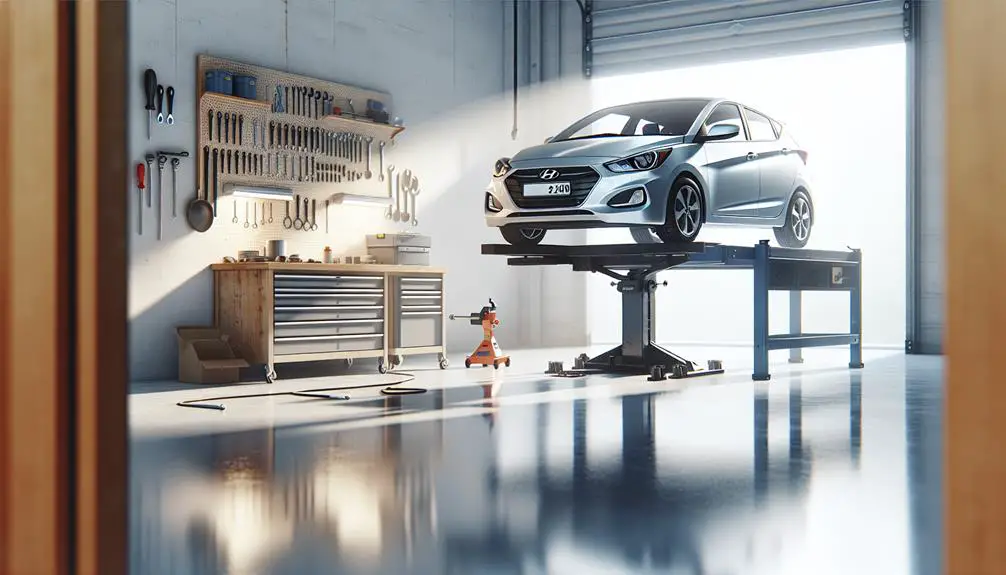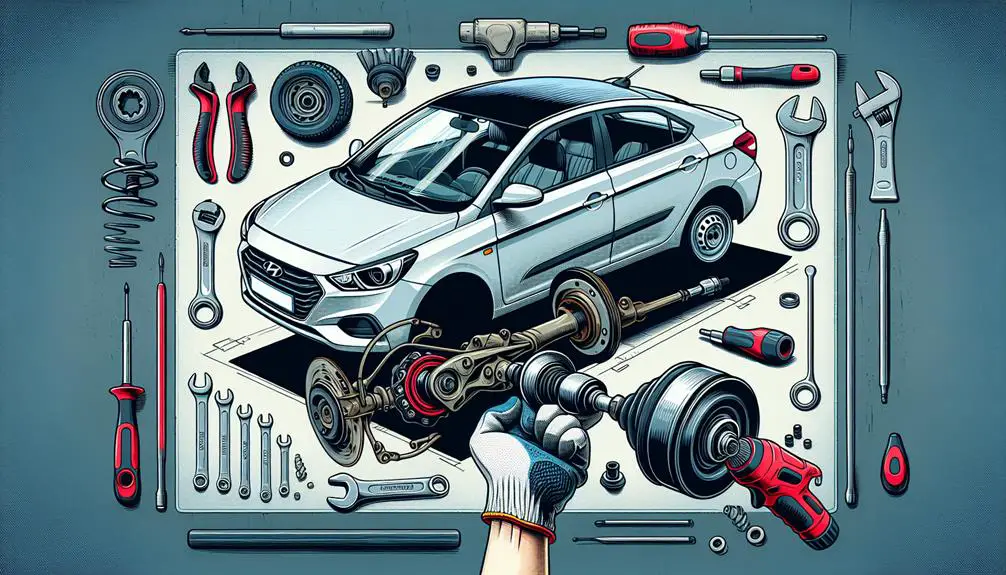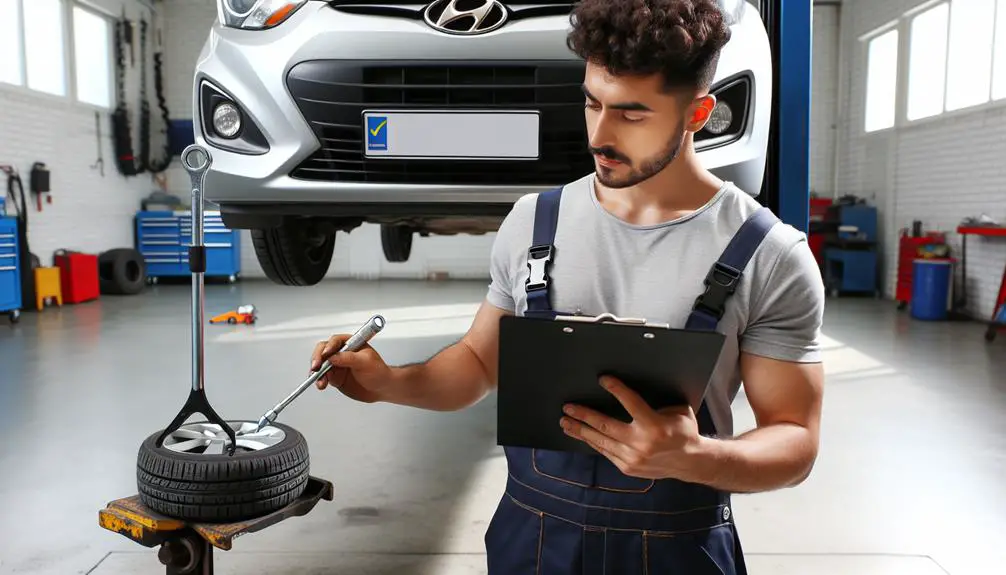Setting up your workspace and gathering necessary tools are the first steps in replacing a ball joint on a Hyundai Accent. Carefully removing the old ball joint is crucial to prevent damage to other components. Correctly installing a new one is essential to ensure safety and optimal vehicle performance.
It is important to follow the manufacturer's instructions and guidelines while working on the ball joint replacement process. Proper installation is key to maintaining the integrity of the suspension system and ensuring the vehicle's stability while driving.
Preparing Your Workspace

Before beginning the ball joint replacement on your Hyundai Accent, make sure your workspace is clean, well-lit, and spacious enough to work comfortably. You're going to need room to move around, along with space for any parts and tools you're not currently using.
Initially, clean the area. You don't want any dust or debris to get into the vehicle's components. A simple sweep and wipe down can make a huge difference in keeping the work environment safe and clean. Next, good lighting is essential. You need to see what you're doing clearly to avoid any mistakes or injuries. If your garage or workspace isn't well-lit, consider getting a portable lamp or work light.
Consider the floor where you'll be working. Ideally, it should be flat and stable. Uneven surfaces can make it difficult to use a jack safely. If your workspace's flooring isn't ideal, you might need to find a more suitable spot or lay down some plywood to create a more stable surface.
Moreover, think about ventilation. You'll be working with chemicals and materials that could be harmful if inhaled in a closed space. Make sure there's enough airflow, or use fans to circulate air if necessary.
Gathering Necessary Tools
To successfully replace the ball joint on your Hyundai Accent, you'll need to gather a few indispensable tools.
First, you'll require a socket set. This set should include a range of sizes, as you'll encounter different nut and bolt sizes during the replacement process. Make sure you've got both metric and standard sizes since you never know which one you'll need until you're in the thick of it.
Next, a torque wrench is vital. It's not enough to just tighten bolts; you need to tighten them to the manufacturer's specified torque. This guarantees everything is secure and operates correctly, reducing the risk of future issues.
Don't forget a jack and jack stands. You'll need to lift your Hyundai Accent safely to access the ball joint. Make sure the jack and stands you choose are rated for your car's weight. Safety first – always.
A ball joint press or a universal press tool is another must-have. This tool helps you remove the old ball joint and install the new one with precision. It's a game changer and makes the job much more manageable.
Lastly, a set of pliers, a hammer, and a flathead screwdriver should be within arm's reach. These tools might seem basic, but you'll find them incredibly handy for different tasks during the replacement process, such as removing clips or nudging parts into place.
Removing The Old Ball Joint

Having gathered all the necessary tools, let's get started on removing the old ball joint from your Hyundai Accent.
Initially, your car's safely lifted and supported on jack stands with the wheel removed. You'll be working in the area where the wheel attaches, so safety's paramount. With your gloves on and eye protection in place, locate the ball joint. It's the pivot point between the wheel hub and the suspension arm.
Next, you'll need to tackle the cotter pin and castle nut securing the ball joint. Use your pliers to straighten and remove the cotter pin, then grab your socket wrench to loosen the castle nut. However, don't completely remove it yet; leaving it on the end of the thread can prevent the control arm from dropping suddenly once the ball joint is free.
Now, it's time to break the ball joint loose from the steering knuckle. This might require a ball joint separator or a few careful taps with a hammer and chisel. Be gentle but firm; you don't want to damage the surrounding components.
Once the ball joint is loose, you can remove the castle nut entirely. If your model has any bolts attaching the ball joint to the control arm, unscrew these too. With everything detached, you can now take out the old ball joint. It might need a bit of persuasion, so be prepared to wiggle and tug it free.
You've successfully removed the old ball joint, setting the stage for the new one to be installed.
Installing The New Ball Joint
With the old ball joint removed, you're now ready to install the new one into your Hyundai Accent. This step is important for ensuring your vehicle's suspension is restored to its best condition. Here's how you'll get it done:
- Prepare the New Ball Joint: Make sure the new ball joint is the correct model for your Hyundai Accent. It's necessary to compare it with the old one to confirm they're identical. Before installation, check that all parts of the new ball joint are present and in good condition.
- Position the New Ball Joint: Carefully place the new ball joint into the socket. It's important to ensure it fits perfectly. Any misalignment can cause significant issues later, so take your time to get it right. If it's a press-fit ball joint, you may need to use a ball joint press tool to install it securely.
- Secure the Ball Joint: Once the ball joint is in place, start by hand-threading the bolts or nuts that secure it. This step helps prevent cross-threading. After hand-threading, use the appropriate tools to tighten the bolts or nuts to the manufacturer's recommended torque specifications. It's important not to over-tighten as this could damage the new ball joint.
- Reattach the Components: Reattach any components that were removed during the ball joint removal process. This includes the control arm, the tire, and any suspension parts. Make sure all bolts and nuts are tightened properly to ensure everything is secured.
Testing and Final Checks

After installing the new ball joint on your Hyundai Accent, it's vital you test and inspect all components to make sure everything's working perfectly. Begin by carefully lowering your vehicle from the jack stands, making sure it's securely on the ground. It's critical to maintain safety throughout this process.
Next, you'll want to take your car for a short, slow test drive on a safe, flat surface. Pay close attention to the steering responsiveness and listen for any unusual noises, such as creaking or clunking, which might indicate something's not quite right. If you hear or feel anything out of the ordinary, it's crucial to immediately recheck your work.
Upon returning, it's wise to reinspect the ball joint and surrounding area. Make sure the ball joint's securing hardware is still tight and hasn't loosened during the test drive. This is also a good time to double-check that there's no excessive play in the ball joint itself. You can do this by jacking up the front of your Hyundai Accent slightly, then using a pry bar to apply pressure to the tire's bottom edge, mimicking the leverage forces it would experience during normal driving. There should be minimal to no movement if everything is correctly installed.
Lastly, don't forget to verify that your wheel alignment hasn't been thrown off by the repair. A misaligned car can lead to uneven tire wear and poor handling, negating the benefits of your hard work. If you're unsure, a professional alignment check can provide peace of mind and ensure your Hyundai Accent drives smoothly and safely.
Conclusion
After carefully preparing your workspace and gathering all necessary tools, you've successfully removed the old ball joint from your Hyundai Accent and installed the new one. It's important to make sure everything is tightly secured during installation.
Now that you've completed the process, it's time to test your work. Take your car for a gentle drive, paying close attention to its handling and any unusual noises.
With this final check, you can confidently enjoy your smoothly running vehicle, knowing you've done a great job.